
The enormous amount of data produced per day is mad. We consume so much information on a daily basis, it’s no wonder many suffer from information overload.
Taking a tour through our brain would be like aimless meandering through a gigantic archive of information, files, and references. It’s no wonder that when we find interesting information we wish to retain, we either write it down on a notepad, put it on a sticky note on our desk, or save it in a digital file on our computer.
What’s the Problem with Note-Taking?
Sadly, most of the time, those ideas and information get forgotten and lost. Without proper organizational structure, your data can quickly become a pile of chaos and due to the overwhelming amount, regularly sorting and organizing your notes is the only way to keep them usable.
Similarly, how often do we take notes intending to utilise the information in the future, only to forget they even exist later on? Pieces of information without a clear description of their original intent for keeping or collecting it in the first place results in an assortment of miscellaneous information without any connection to a train of thought.
For those seeking to master knowledge building and transform their thinking, the Zettelkasten system is a great starting point.
What Is the Zettelkasten method?
The Zettelkasten method is a personal strategic process for thinking and writing. As one of the most effective knowledge management methods, it can best be described as an organization system that helps you organize your knowledge while working (studying or researching)
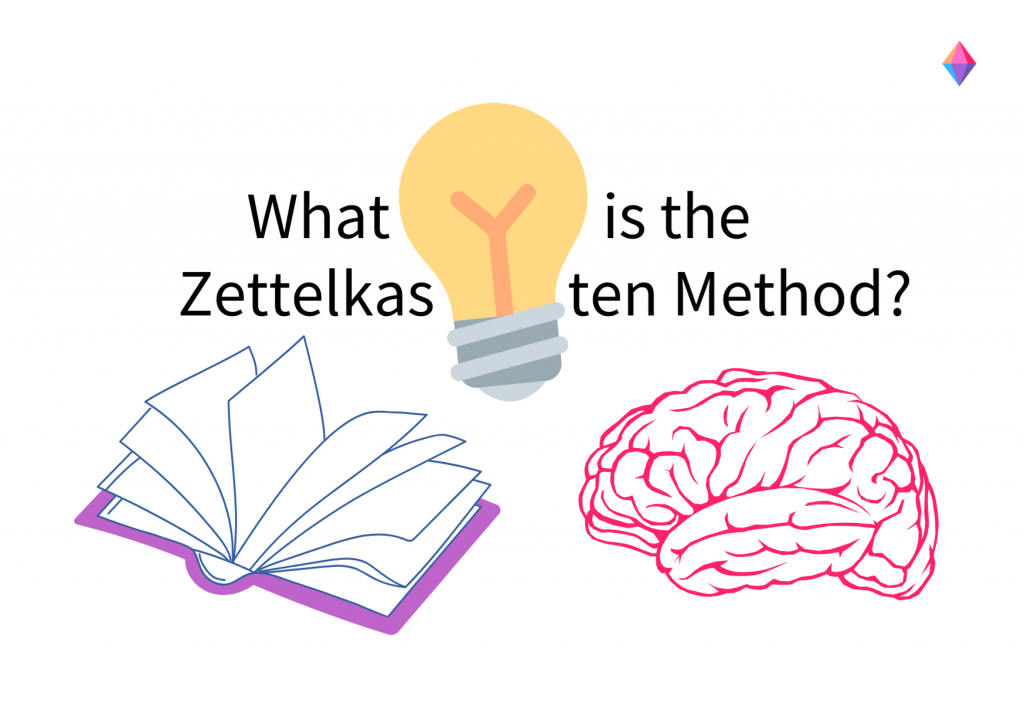
.
What makes the Zettelkasten method so great is that the system not only helps you store and organize your knowledge but also improves your memory and knowledge retention. Developing knowledge relationships significantly improves memory recall, and forming them also trains your mind to see patterns.
We need to understand how our minds work so we can work our minds better.
— Jim Kwik, mind coach and author of Mindvalley’s Superbrain Program
The Zettelkasten method encourages you to connect the dots between different trains of thought and knowledge. The steps facilitate our intrinsic ability to generate new connections between ideas and thus increase our knowledge and productive output.
The Zettelkasten method is good for when you want to:
- Systematically organize important information
- Find information again, even years later
- Develop your own ideas
In short, the Zettelkasten method is an integrated system for dealing with knowledge in your life and acts as an amplifier of your endeavors in the realm of writing and knowledge management.
What Is a Knowledge Management System?
Knowledge management (KM) is the process of creating, sharing, using, and managing knowledge and information. The main objective is to make the best use of existing knowledge.
When creating a personal knowledge management system, you ultimately develop a system and structure for organizing your ideas, thoughts, and information in a way that suits your thinking. In a way, you develop a web of knowledge and build up a “second brain” of all the information that you collect to help fuel an emergent approach to thinking.

Set up your personal knowledge management system.
Try our all-in-one project management software for free now!
Definition of Zettelkasten
Zettelkasten is a german word which translates to ‘note box’. The definition explains what material to work with and the filing system used. Let’s break it down into its parts:
A ‘zettel’ is a slip or note of paper. Information we wish to keep gets written on a Zettel. A classic form of a Zettel is a sticky note, an index card, or a piece of notepad paper for writing down your thoughts.
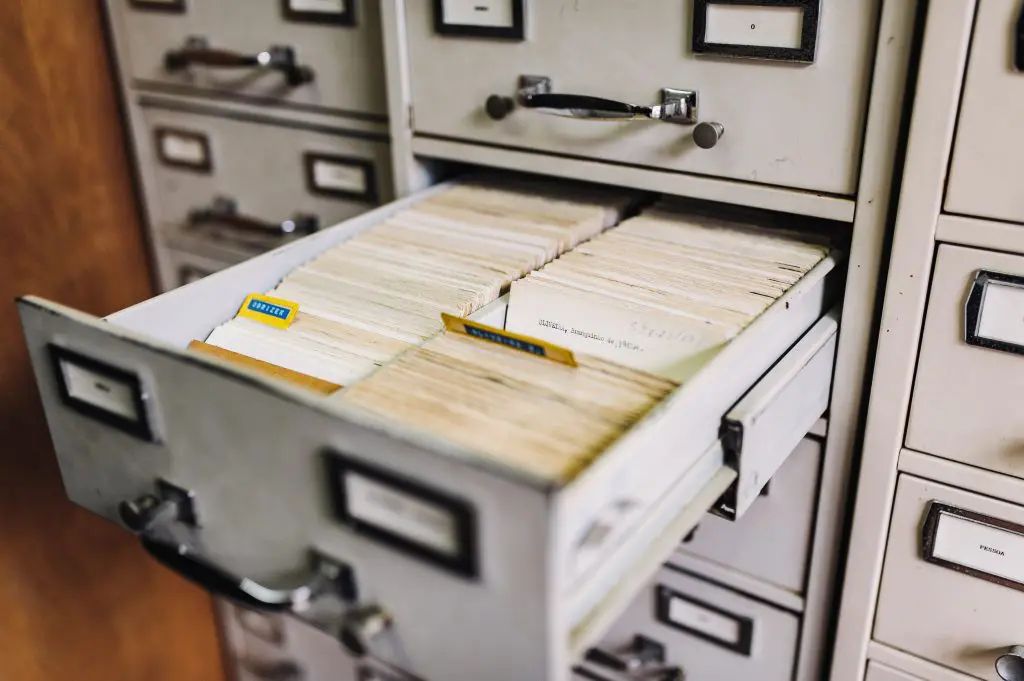
The word ‘kasten’ literally translates to box. In this context, however, it’s specifically an index card box. Index card boxes allow for an organized filing system keeping like-minded notes or zettel grouped and categorized in one place.
Following the definition, the Zettelkasten method can be explained as an index card knowledge management system that helps you to retain information that resonates with you, which you then organize, identify, and categorize, to ultimately convert into creative output.
In short, a Zettelkasten is simply a framework to help organize your ideas, thoughts, and information. By relating pieces of knowledge and connecting information to each other (by way of hyperlinking), you are replicating a train of thought. By establishing relationships between pieces of knowledge, you are helping retain consumed information allowing your thinking process to grow organically.
Who Is Niklas Luhmann?
Niklas Luhmann is the brain behind the system. The german sociologist is the founder of the smart note-taking and knowledge management system, the Zettelkasten method. He was extremely productive in his career, writing 70 books and more than 400 scholarly articles!
As a researcher, Luhmann was constantly reading and learning. In order to build upon his existing knowledge, he developed the systems theory we know as Zettelkasten today. Luhmann focused on understanding the information he read and making connections to existing information. For this, he used a paper-based system to categorize all the information he read and collected.

Luhmann collected information on a Zettel, categorized and filed it appropriately in his archive, which was indeed a piece of furniture with lots of drawers. He meticulously built a web of his knowledge that helped him retrieve information and develop new ideas efficiently.
To translate Luhmann’s Zettelkasten method to our digital age, his method of organization is an analogue system to what we now know as hyperlinking. Thus, the Zettelkasten system can be likened to or described as the first Wiki.
Zettelkasten Method Explained
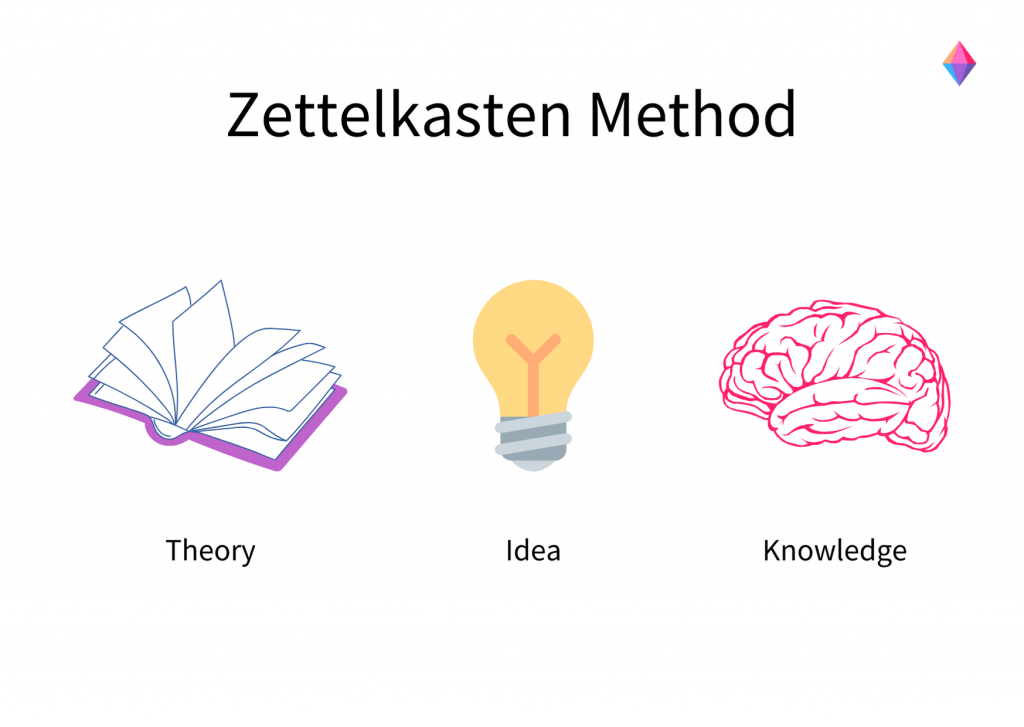
How Does the Zettelkasten Method Work?
The Zettelkasten method helps you collect and organize your thoughts, ideas, and information in a structured or categorical way. Following the steps and technique, you can build upon your existing knowledge and create a knowledge archive of your files and information that are a near-enough replica of the system of how your brain works.
Zettelkasten method comprises three main types of notes:
- Literature Notes
- Reference Notes
- Permanent Notes
Each note has a distinct objective and serves a specific function. Other types of notes include fleeting notes and hub notes.
Types of Notes
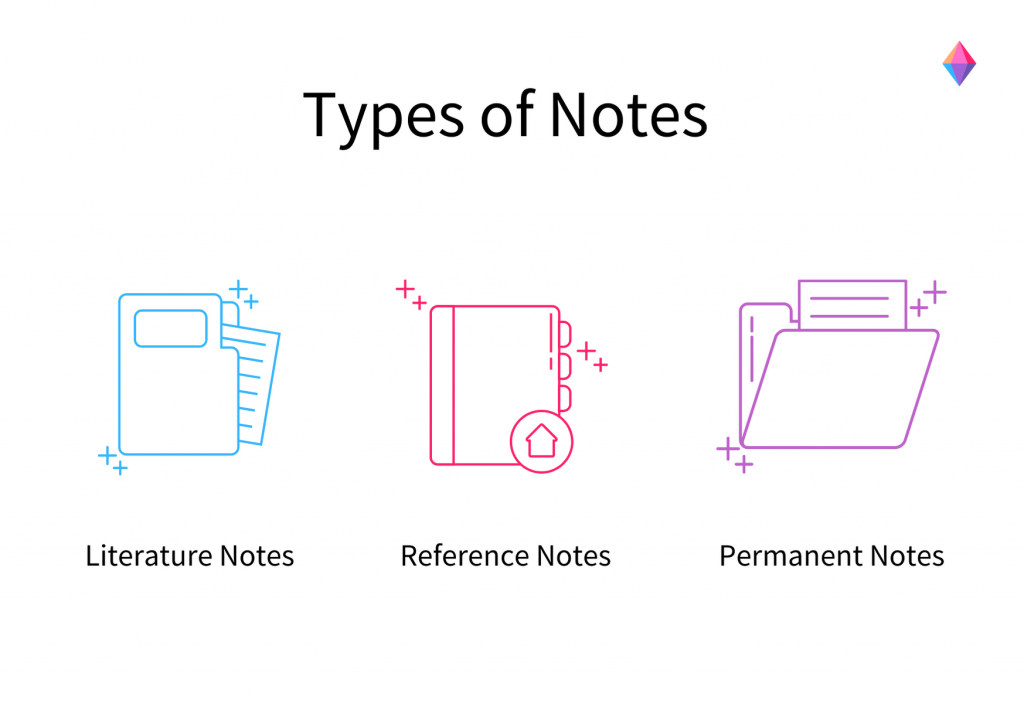
Literature Notes
Oftentimes when working or reading for leisure, there’s a particular text we either wish to highlight or jot down for future reference. Literature Notes are the notes you make as comments to the text you have selected or marked down.
Taking literature notes adds context and helps you remember the thoughts you had when reading or writing down the information. The whole point of adding comments to the text you highlight is to help you summarize the point of the text, to include your thoughts and your key takeaways from it.
The worst feeling when researching and taking notes is finding notes you previously made without any helpful context as to why you wrote the information down in the first place. Taking good notes is important so you don’t ever have to double back on your work.
Tip: It’s best to write down more information than later necessary.
For research purposes, make it a habit to include the book title, author, chapter, and page number. If you find yourself needing further context than your comment and notes provide, you won’t have to search the entire book to find the exact location you referenced to. Instead, you can immediately open to the right chapter your note addresses.
Reference Notes
The technique of grouping information, organizing ideas into categories, and creating tags to help you find grouped information at a later stage is the art of reference notes. When we reference something, it is safe to say that the topic or idea we are writing about is part of a bigger topic or is information accredited to someone or someplace else. We use this technique in various daily circumstances and the function is available on almost every software and app available today.
Common ways we use referencing in everyday life include the use of the hashtag (#) on social networking platforms, attributing credit when writing a thesis paper, or when adding a hyperlink to the source location of a particular referenced media file such as pictures, GIFs, or videos. Using a search engine when interested in a particular keyword and tagging others or replying to messages in chat apps also constitutes referencing. Helpful ways to mark reference notes include applying a hashtag when using digital software, color coding, or including a unique ID address.
Permanent Notes
Permanent notes are stand-alone ideas that can be made without any direct context to other sourced information such as books, videos, or other available data.
Permanent notes can be made as a recap or summary of the information just researched or learned, but can also be thoughts that popped into your brain while thinking over a myriad of information or while analysing any given context.
The aim of permanent notes is to process the notes you have made and analyze how they affect your interests, thinking and research. You then cherry-pick the notes that add value to your existing ideas and connect the new information to what you already know and have saved in your database.
Fleeting Notes
Because our brain works 24/7 and our thinking cannot be contained to a dedicated note-taking moment, we might take notes on the go. When you jot down the random ideas, thoughts and information that untimely flow through your mind, you are taking fleeting notes.
Fleeting notes are unstructured and unorganized notes. They serve as temporary holders of information for later use that you will need to organize into your system. In short, fleeting notes are temporary reminders of ideas.
Using the Zettelkasten Method to Take Smart Notes
There aren’t many steps in the Zettelkasten method, which makes it seem like a relatively simple system. Don’t be fooled by the numbers! The complexity and benefit are ultimately up to the quality and quantity of information you collect and input, and strongly based on the organization structure you choose.
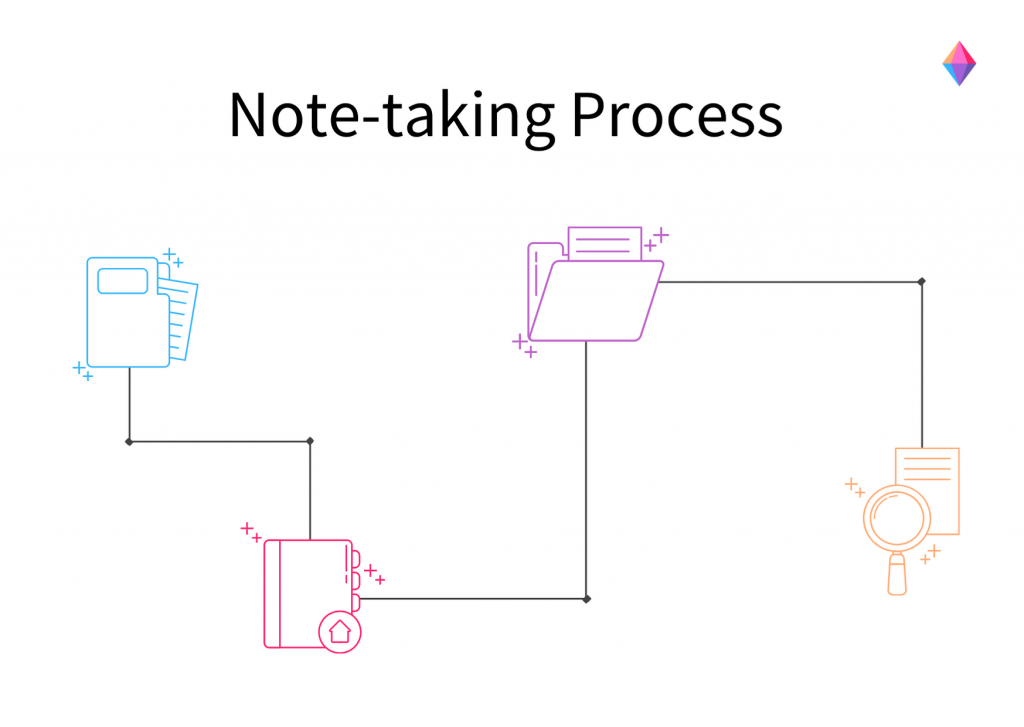
Make sure to understand how your brain analyzes information best before adjusting your note-taking habits. You can certainly employ ‘learning by doing’, but you might end up backtracking, reorganizing, and renaming files to fit into the categorizing you later decided upon.
The Zettelkasten method is about optimizing your workflow of learning and producing knowledge. Figure out your learning and note-taking style and be consistent in applying the steps in the Zettelkasten method:
Step 1: Read and take smart notes
When working, write down your thoughts and the reason why you are taking particular note of a piece of information. This way, you will better understand the focus and reasoning behind the information you jot down. Even better, summarize the information and write it in your own words as much as you can.
Step 2: Rewrite your notes for the Zettelkasten
Once you have collected and summarized the information, it’s time to highlight some key elements. Include index information like the author’s name, book location, or the link URL. For longer Zettels, highlighting the learning objectives or key points in a bullet list might be helpful. The main point is to write your notes in such a way that you will easily be able to quickly get the gist of the material when you come across it again.
Step 3: Adding a structure to your Zettel
The objective of using the Zettelkasten method is to make knowledge relationships. Add a particular #category or number-ID to the individual Zettels to help you link them to another in your system. Doing so will allow you to jump from a related idea or piece of information to the next without having to search through your archive for particular keywords.
You may come to a point where your database is filled with Zettels, expertly organized and linked to another, but you have lost the overview. In this case, you can create Hub notes to help you. Hub notes are Zettels about a certain topic with subtopics. They are similar to the index or the table of contents. Use hub notes as a reference or index for your work. Write down the list of topics in your Zettelkasten with a description and reference number to help you find and access information easier and quicker.
Step 4: Ask questions and review as a habit
Note-taking or note-collecting is great, but having access to a significant amount of information doesn’t make you smarter. Ask yourself questions when analyzing the information to help you develop your own ideas for the content or material. Make it a regular habit to review information in your Zettelkasten to jog your memory and encourage you to see patterns and create connections between ideas and information.
How to Implement the Zettelkasten Method Into Your Workflow
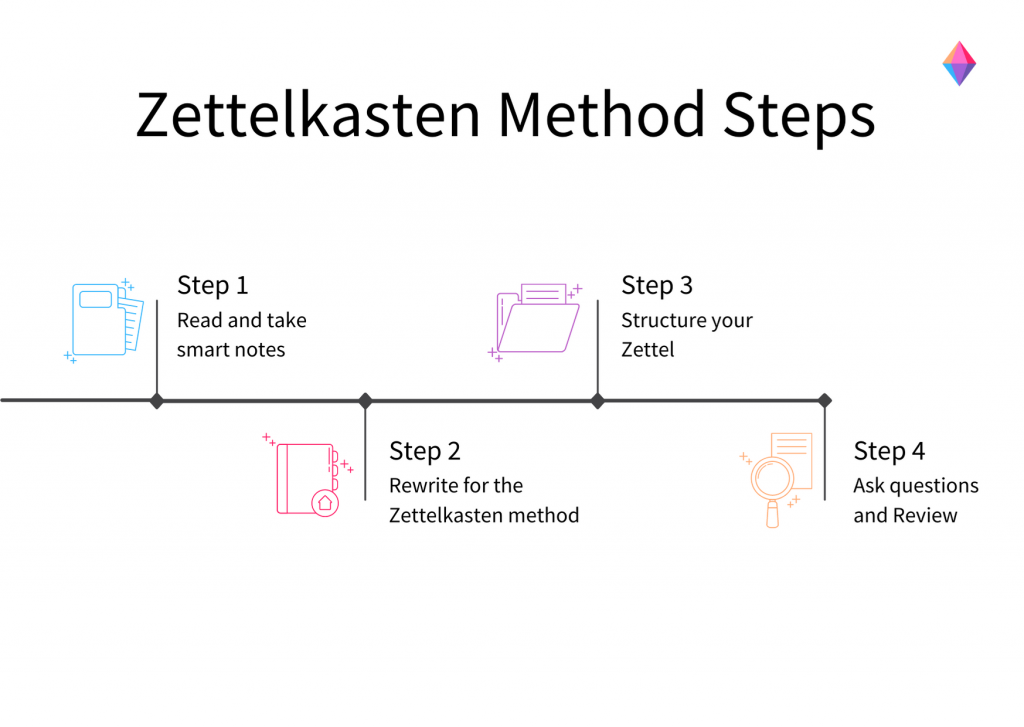
As mentioned, the steps and techniques in the Zettelkasten method are to help you retain your knowledge and develop new ideas. This means that you can use tools and software and tailor the functions to structure how your thought process works.
Selection of Zettelkasten method types:
- Software-based Zettelkasten: It’s certainly super handy having all your notes in digital form. Instead of adjusting and renaming your folder structure on your computer, you could consider using a knowledge management software (psst, Hypernotes!) that uses the Zettelkasten method. Software-based Zettelkasten already have integrated features to make smart note-taking so much easier, such as auto-connecting related notes, and syncing to multiple devices.
- Paper-based Zettel: You may enjoy the manual practice of writing down information and keeping index cards in a folder or designated filing cabinet in your home. Just because it isn’t digital, doesn’t mean you’re not going to be productive (Niklas Luhmann is proof of this!).
- Archive / DocuWiki: If you’re not picky on the design or format and value the text-based information, using a DocuWiki as a Zettelkasten might be right for you. DokuWikis store plain text filled with simple markup locally in a folder on your computer and use the renaming function to create folders as document categories, just like drawers in a filing cabinet.
Whichever Zettelkasten type you choose, remember that there is no perfect note-taking system, only the best one suited for you. Just like when creating a second brain, the note-taking system needs to be suited to your personality and workflow to help you be productive and truly efficient.
Tip: Choose a system type that fits your personality and thought process, and is best suited for the type of work you do.
Images from Jan Antonin Kolar and Maksym Kaharlytskyi from Unsplash
Final Thoughts
The Zettelkasten method is an excellent system encouraging the emergent approach to working through information. Setting up a system and organizing a structure that suits you best is the hard part. After the first steps and with continuous practice, you’ll soon be a walking information archive and impress your family, friends and colleagues with your knowledge.
Everyone has a particular system they enjoy. We’d love to know how you take notes and work through your ideas.
Wishing you a productive lifetime of smart note-taking!
Cheers,
Jessica and the Zenkit Team





Leave a Reply